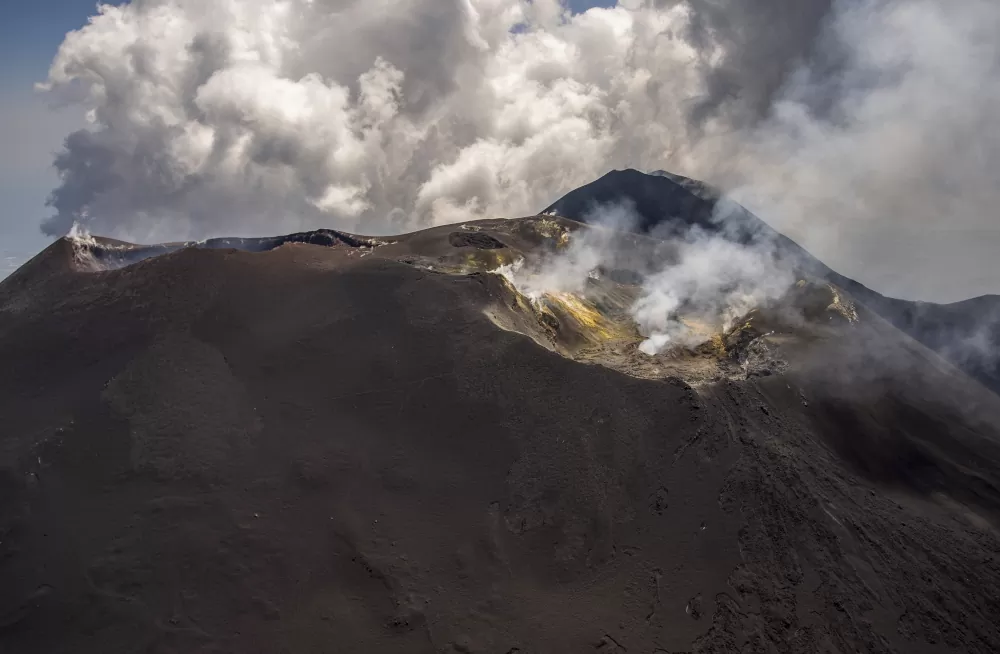The Central Crater, probably formed during the great eruption of 1669 on the ruins of another pre-existing cone, consists of a 500 m diameter mouth at the centre of a 250 m high cone.
Looking at Etna from the sea or from the coast, from the foot of its eastern flank, one can clearly see that this cone is in fact only the last, the youngest peak that has formed on this great giant – within a much larger, pre-existing volcanic structure. It can be clearly seen that the large flanks of the volcano do not converge with the flanks of the main crater, but end with two promontories on either side of the central cone, Pizzi Deneri (2850 m a.s.l.) to the north and Montagnola (2613 m a.s.l.) to the south, clearly separated by plateaus, Piano delle Concazze and Piano del Lago respectively.
Voragine
In the main crater, a collapse in the ground occurred in October 1945, very close to the northern rim of the crater, creating a “shaft crater” or “pit crater”. It was called Voragine (maw).
The activities emanating from this opening were usually quite violent, but fortunately not very frequent. Perhaps it is because of the location to the main shaft coming out of the magma chamber at probably 30km depth that the eruptions have always been spectacular.
The most important outbreaks took place in 1960, 1998 and in September 1999. There was a lighter eruption in 2013 and the December 2015 eruption made famous by the fantastic images of the 15 km high column of ash, called a jet, which opened like an umbrella and took the shape of a mushroom cloud. However, this was not the only eruption to reach this size; several of these eruptions produced a lava column 10 to 15 km high.
The May 2016 eruption, on the other hand, caused a spill that breached the wall between Voragine and Bocca Nuova to the south, filling Bocca Nuova with lava. The lava then managed to break through the western edge and flow down the flank towards Bronte. Fortunately, the lava flow stopped before it reached potentially dangerous heights for the population. Another feature that occurred after this eruption is the vent that opened near the northwest rim. It initially had temperatures in the 700 degree range and began to decline in November 2017 when the northeast crater resumed activity.
Bocca Nuova
In spring 1968, Bocca Nuova (“new mouth”) opened, closer to the southern rim of the central crater. Originally it had a diameter of only 8 metres, which gradually increased, mainly as a result of the subsidence of the surrounding material (subsidence) that formed the floor of the old main crater, which had increased the diameter of Bocca Nuova to 350 metres by 1977.
A diaphragm gradually formed between the two craters Voragine and Bocca Nuova, which in recent decades has also collapsed at times and then gradually reformed.
From 1997 onwards, the activity inside the crater increased and led to a gradual filling of the crater, which resulted in violent strombolian activity in autumn 1999. In the following decade, however, the crater floor subsided again until 2011, when new strombolian and effusive activity occurred.
A particularly noteworthy episode for me in recent years occurred on 10 October 2016. You may wonder why this is of particular importance to the author. Well, I am writing here because I luckily descended from the edge of the main crater in time.
But let’s take a step back and start again, because what happened that day is a consequence of Voragine’s outbreaks in 2015 and 2016, which I have already described. During these eruptions, between 4 and 5 million cubic metres of lava poured into the Bocca Nuova, filling it to the brim and creating a huge cinder field that solidified and formed a kind of giant plug.
This event immediately caused concern among volcanologists and connoisseurs of this sector, as the closure of a main shaft does not bode well in any case. And precisely on 10 October 2016, there was a sudden explosion that shattered the plug and caused it to sink more than 30 metres. Fortunately, there were no casualties as the visiting groups, of which I was one, had recently left the summit area.
Today the great Bocca Nuova is in continuous evolution, alternating between filling and sinking phases.
